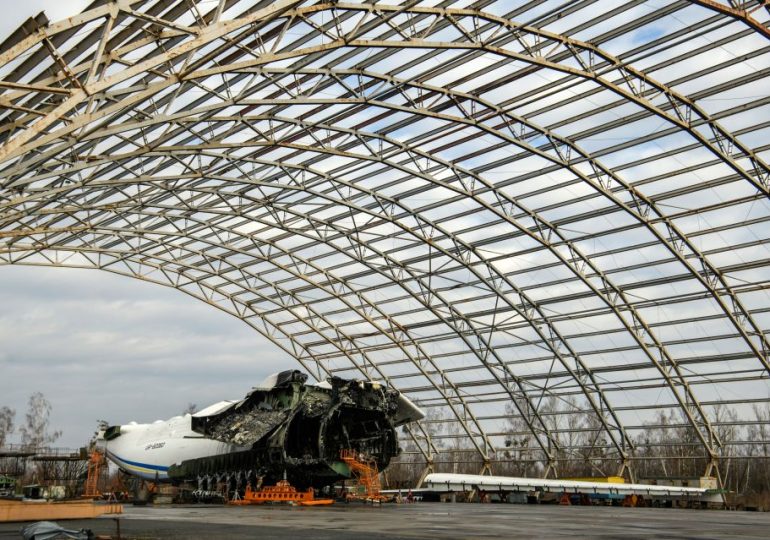THIS IS Ukraine’s abandoned Hostomel Airport, a war-torn airstrip that thwarted Russia’s seizure of Kyiv in the early days of Putin’s brutal invasion.
Now home to the wreck of the world’s largest plane, fragments of other aircraft, and a non-functional landing strip, the airport’s battle scars tell the tale of Russia’s worst blunder.
RexThe Airport in Hostomel was Putin’s first point of attack in his brutal invasion[/caption]
APUkrainian servicemen photographed in Hostomel on April 2, 2022 after expelling Russian troops[/caption]
GettyThe world’s largest cargo aircraft was destroyed in the battle[/caption]
The invasion
It was February 24, 2022, when the Russian tyrant sent a squad of tens of helicopters to take Hostomel.
Flying so low the Ukrainian military couldn’t see them, it wasn’t until they started shooting at the airport that their position was revealed.
Head of the airport’s control and dispatch centre Volodymyr Smus recalled how the onslaught of helicopters took him by surprise.
Speaking to Global News, Smus said: “We were not prepared for war.
“The airfield was preparing for the reception of Boeing and Antonov planes.
“Missile strikes on the territory of the airfield were considered at planning meetings. But [not] a full-scale invasion.”
Having been warned about the possibility that Putin would attack the airport, Smus had been on-site alongside dozens of other employees trying to protect the planes.
The decision was made to move the aircraft to different areas around the airport so that it wouldn’t be destroyed in the first attack.
Begrudgingly, they also decided to leave Mriya – the mammoth of a plane that had twice the capacity of a Boeing 747 – in its hangar, to protect pilots from the potential being shot.
Not long after, the helicopters arrived.
Tens of airport employees were still on-site, forced to run for cover as the Russian invaders opened fire.
80 employees made it into the bomb shelter, while others had no choice but to dive into the sewers.
The defence
Commander of the Ukrainian airfield’s national guard, Vitalii Rudenko, had been warned of conflict hours earlier.
He and his unit of 120 soldiers had been preparing for war for almost a week, but he still couldn’t believe it was happening.
Rudenko told Gobal News: “We didn’t see them because they flew so low to the ground.
“We saw them when they came above the trees and they started shooting at the airport.”
“I probably didn’t believe until the last moment that this was possible, that a full-scale offensive was possible, but after the first group of helicopters, I understood that it had really begun.”
Ukrainian military described a terrifying scene of a flying tank, known as the Mi-24 helicopter, being tailed by 30 helicopters – including a K-52 Alligator, thought to be the chopper capable of the most damage.
Rudenko told his troops to aim at the sky.
He said: “When we received the shelling from the helicopters I gave the order to fire back.
“We were trying to shoot down the helicopters.”
Rudenko’s unit were able to destroy six, damage two more, and force the K-52 to crash into the Dnieper River.
The defence was able to hold it’s ground, until the paratroopers arrived.
Troops poured out in their masses, turning a barrage of machine guns onto Rudenko’s comparably small unit.
Rudenko said: “Our enemy dominated us in the air, and they had many more paratroopers.
“To save the lives of our team, we had to retreat.”
It later emerged that an airport employee had been corrupted by Russian intelligence to give these positions away.
The battle
Despite an initial victory against the Ukrainian defence, the Russians were no match for the local armed civilians who rushed to help their soldiers.
Civilians, assisted by Ukrainian artillery – who shelled the airport’s landing strips to prevent Russian planes from landing – pushed back against the invaders.
These civilians played an essential role in holding ground to allow a large-scale counterattack from the National Guard and Ukrainian Air Force.
Ukraine rushed in hundreds of troops, whilst warplanes that had survived the first Russian missile strikes were used to protect units on the ground.
Russian aircrafts with reinforcements were deterred from landing, and forced to return to Russia.
By the evening on February 24, Ukrainian military had surrounded the airport.
The oncoming days saw an invigorated push from the Russian side – with armoured vehicles from Belarus accompanied by heavy air strikes.
Some of the vehicles that set out from Belarus on February 25 were ambushed, but Russian reinforcements were eventually able to enter the airport.
The Ukrainian defenders were quickly expelled, and claims emerged that Russia had taken Hostomel.
Although the Ukrainian Ministry of Internal Affairs initially denied that Russia had captured the airport, by February 26 it had been confirmed.
On February 27, Russia turned its attention from the airport towards the towns of Bucha and Irpin – where they had previously been blocked by Ukrainian resistance.
Try as they might, besieging the towns, killing and torturing anyone that stood in their way, they still couldn’t break through the defence.
That same day, Ukrainian military bombarded the airport with artillery.
Countless Russian equipment, vehicles and personnel were destroyed in the process.
As was Ukraine’s most prized aircraft, the Mriya, which Russian media aired footage of during the battle.
The Russians were able to partially repair the airport over the next few weeks, but it was longer a functional airstrip.
The downfall
Ukrainian personnel who who fought in the battle say the Russian downfall can be pinpointed to how much they underestimated the nation’s military tactics.
The Ukrainian military were able to adeptly manipulate the terrain – destroying their own infrastructure, like the airport, roads, bridges and the like.
They also deployed guerrilla tactics, like shelling during the night, reducing the Russian troops’ morale and forcing them into kill-zones.
Just 30 kilometers away from the airport, Ukrainian artillery blew up the Kozarovychi dam, across the Irpin River.
The river flooded the river’s banks and slowed the advance of Russian soldiers – some reports suggested that Russian troops had to swim through the flooding.
The Russians stationed in the area had become sitting ducks.
As of March 28, satellite imagery showed no Russian forces inside the airport, and March 29 saw the announcement of the retreat from Kyiv.
Now, the airport is viewed as the site of Russia’s biggest blunder.
Two years after the invasion, the Italian prime minister, Giorgia Meloni, spoke of Putin’s failures at a ceremony at the abandoned airport.
Meloni said: “This place is the symbol of Moscow‘s failure and Ukraine’s pride.
“Here Putin’s plans were stopped, it reminds us that there is something stronger than missiles and war, love for the land and freedom.”
RexWestern dignitaries have arrived at Hostomel Airport on 24 February 2024 to show their solidarity[/caption]
RexDestroyed Russian military equipment at Hostomel airport[/caption]
ReutersRussian media celebrated the destruction of the Mriya cargo plane[/caption]
RexWorkers are still trying to dismantle the destroyed largest transport aircraft[/caption]
Leave a comment








